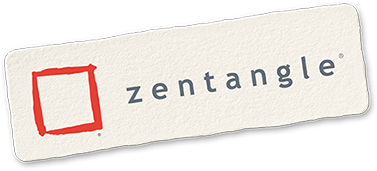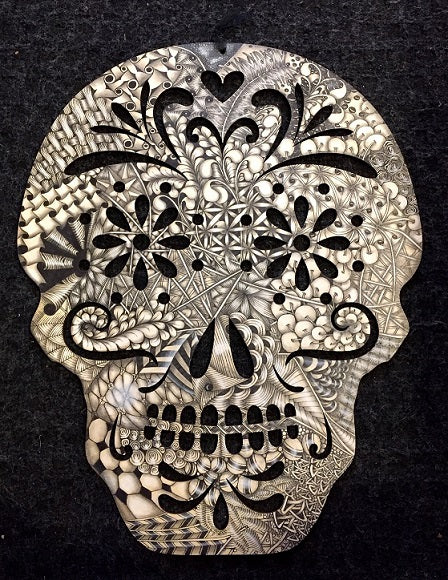Rick writes:
In 2007, we started BLOG Zentangle and began our enjoyable series of conversations within our Zentangle community.
In reading through these blog posts with their insightful comments, we decided to bring a few of them to your attention from time to time. It is easy, for me anyway, to sometimes think of old information as stale information. But these insights and conversations are anything BUT stale!
Today, we invite you to revisit this blog from 2018...
Begin previous post . . .
Molly writes:
This topic comes up often. We see it discussed through different social media portals. People offer many different answers and often ask us to clarify it.
The truth is the definition is a bit gray and we do not get so caught up in finding a fine line to land on. The term ZIA (Zentangle Inspired Art) was organically started to describe artworks that are not drawn on a Zentangle tile but still use the Zentangle Method in the creation of them. For instance a pair of shoes that are tangled, a large canvas covered with Zentangle art, a ceramic dish with a tangled border, a butterfly filled with tangles, a fox, a turtle, etc.

A ZIA is often representational while traditional Zentangle art is almost always non-representational. It was sometimes said that if it had color then it was a ZIA, but in recent years color has become another layer to the complexity that the Zentangle method has to offer.
I feel the Zentangle Method has grown organically as this very simple method continues to bring forth art that is far deeper and more sophisticated than we ever anticipated. And really it is because of all the amazing enthusiastic Zentangle artists all over the world challenging and creating. I am so humbled and thrilled with how awesome it is. The slow addition of color has been delicate and appropriate to what the method stands for. So I realize this doesn't really answer the question.
A basic original Zentangle is a done on a 3.5" square piece of white paper with black ink and shades of gray. It is non-representational. It is created using the Zentangle Method.

That being said we still consider other works Zentangle art as well. Ones that are slightly larger, may include color and so on. We have decided to purposely not get too caught up in this definition and enjoy the grayness in the description ... after all the whole idea is to get people to put pen to paper and enjoy the process.
Tangle on my friends.
--- + ---
We are blown away by all of your thoughtful and creative responses to our last blog, What do You Call a Group of Tangles? We are still going through all of your suggestions and we will reveal the winner in our next blog. We promise it will be worth the wait!



LLS on
Jan ~ Sailandbejoyful~ on
Gloria King on
I understand and appreciate the difference between a “Zentangle” and a ZIA, however, I hope people don’t get too caught up in definitions. The mindset, spontaneity and flow of creativity is what really sets this artform apart. Black and white with shades of grey or adding color – it’s all done because of the love of creating art and being able to finally express our god given talent. Thank you for finding a way to give us this outlet!
LaJuania D on
I have just attended a ‘retreat’ in Cairns, the first one for Australia, organised by CZTs, something I enjoyed wholeheartedly, being freshly inspired by all the Zentangle happening around me. Yes, there was colour used, yes, tiles were different sizes, yes, papers were different colours…..and yes,we all regarded our efforts as Zentangle. The common ground is the focus of mindfulness, of the premise of concentrating on one
Stroke at a time and the feeling of calm appreciation and surprise at the end of a piece of work……I have been seriously tangling since 12th February 2012 and really I love what our tangling is called (Zentangle) but it could be called ‘hobbledy hoi’, and I would still feel the same, as it is how it makes us feel inside which matters and I shall forever remain grateful to Maria and Rick for drawing our attention to this wonderfully rewarding Art form. 👏👏👏👏👏❣️❣️❣️❣️❣️
Sue Zanker on
The creators, a group of tanglers could be a “Flux” just as the pattern Flux has many leaves and can curve into a circle, so individual tanglers meet and usually form a circle.
Viv on
Connie T on
For me, Zentangle has embodied not only the original steps and appreciation, but the expansive growth that happens when your mind and hands are freed to express themselves. You cannot stop that creative process, and the embodiment of the Zen that happens as we create. Just like I refuse to be “pigeon-holed” by labels, so it seems Zentangle goes. There is flux and flow in knowing our minds see beyond what may be presented, and our hands itch to put it down on paper, or canvas, or ceramics, etc.
Ginger White CZT 34 on
Lisa Hoesing on
Viv on
Vivian on
Jody Czt 21
Jody Church on
Jessica Dykes on
Brenda Shaver CZT on
Lisa on
Sue Zanker on
Andrea Kine on
George Weiss
George Weiss on
alejandra schiavoni on
Wanyi on
Rosemary Turpin on
Brenda Campbell on
Dolly Bolen on
I think for me, no up or down is the Zentangle Method while orientation defines ZIA.
Laura cZt22 on
I like the thought of choosing not to over think and still defining ZIA over Zentangle. Zentangle is best when black and white. However, colours add life to any piece of art and are mood lifters. Creativity is boundless and is purely a person’s state of mind.
Mudita on